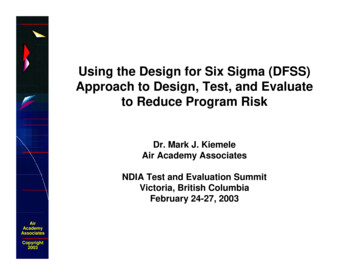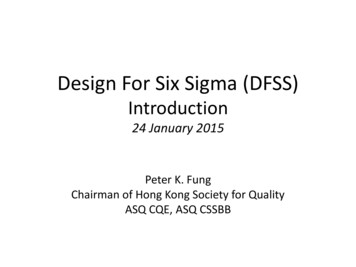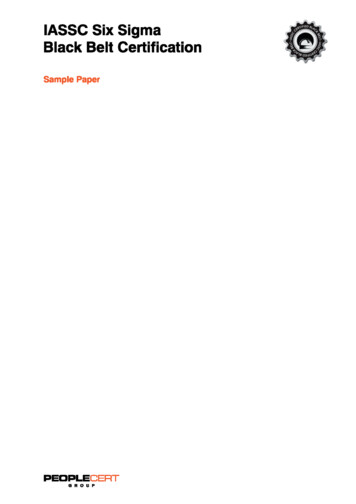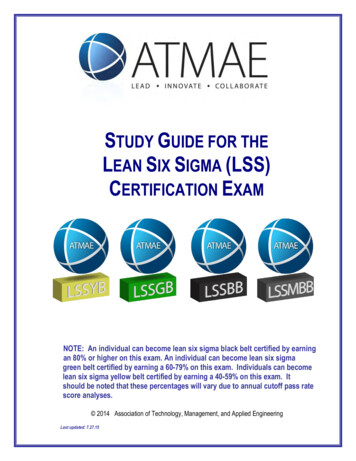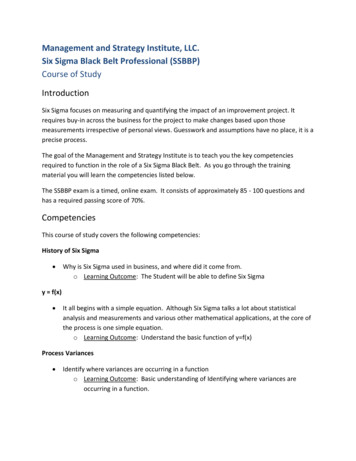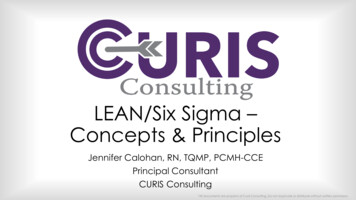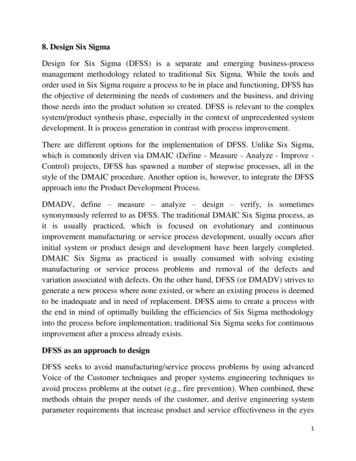
Transcription
8. Design Six SigmaDesign for Six Sigma (DFSS) is a separate and emerging business-processmanagement methodology related to traditional Six Sigma. While the tools andorder used in Six Sigma require a process to be in place and functioning, DFSS hasthe objective of determining the needs of customers and the business, and drivingthose needs into the product solution so created. DFSS is relevant to the complexsystem/product synthesis phase, especially in the context of unprecedented systemdevelopment. It is process generation in contrast with process improvement.There are different options for the implementation of DFSS. Unlike Six Sigma,which is commonly driven via DMAIC (Define - Measure - Analyze - Improve Control) projects, DFSS has spawned a number of stepwise processes, all in thestyle of the DMAIC procedure. Another option is, however, to integrate the DFSSapproach into the Product Development Process.DMADV, define – measure – analyze – design – verify, is sometimessynonymously referred to as DFSS. The traditional DMAIC Six Sigma process, asit is usually practiced, which is focused on evolutionary and continuousimprovement manufacturing or service process development, usually occurs afterinitial system or product design and development have been largely completed.DMAIC Six Sigma as practiced is usually consumed with solving existingmanufacturing or service process problems and removal of the defects andvariation associated with defects. On the other hand, DFSS (or DMADV) strives togenerate a new process where none existed, or where an existing process is deemedto be inadequate and in need of replacement. DFSS aims to create a process withthe end in mind of optimally building the efficiencies of Six Sigma methodologyinto the process before implementation; traditional Six Sigma seeks for continuousimprovement after a process already exists.DFSS as an approach to designDFSS seeks to avoid manufacturing/service process problems by using advancedVoice of the Customer techniques and proper systems engineering techniques toavoid process problems at the outset (e.g., fire prevention). When combined, thesemethods obtain the proper needs of the customer, and derive engineering systemparameter requirements that increase product and service effectiveness in the eyes1
of the customer and all other people. This yields products and services that providegreat customer satisfaction and increased market share. These techniques alsoinclude tools and processes to predict, model and simulate the product deliverysystem (the processes/tools, personnel and organization, training, facilities, andlogistics to produce the product/service) as well as the analysis of the developingsystem life cycle itself with proper investigation results and gains to ensureabsolute customer satisfaction with the proposed system design solution. In thisway, DFSS is closely related to systems engineering, operations research (solvingthe knapsack problem), systems architecture, workflow balancing, and concurrentengineering and even more. DFSS is largely a design activity requiring specializedtools including: quality function deployment (QFD), axiomatic design, TRIZ,Design for X, design of experiments (DOE), Taguchi methods, tolerance design,robustification and Response Surface Methodology for a single or multipleresponse optimization. While these tools are sometimes used in the classic DMAICSix Sigma process, they are uniquely used by DFSS to analyze new andunprecedented systems/products.Distinctions from DMAICProponents of DMAIC and Lean techniques might claim that DFSS falls under thegeneral rubric of Six Sigma or Lean Six Sigma. It is often seen that the tools usedfor DFSS techniques vary widely from those used for DMAIC Six Sigma. Inparticular, DMAIC practitioners often use new or existing mechanical drawingsand manufacturing process instructions as the originating information to performtheir analysis, while DFSS practitioners often use system simulations andparametric system design/analysis tools to predict both cost and performance ofcandidate system architectures. While it can be claimed that two processes aresimilar, in practice the working medium differs enough so that DFSS requiresdifferent tool sets in order to perform its system design tasks. DMAIC Six Sigmamay still be used during depth-first plunges into the system architecture analysisand for "back end" Six Sigma processes; DFSS provides system design processesused in front-end complex system designs.2
Traditional six sigma methodology, DMAIC, has become a standard processoptimization tool for the chemical process industries. However, it has become clearthat the promise of six sigma, specifically, 3.4 defects per million opportunities(DPMO), is simply unachievable after the fact. Consequently, there has been agrowing movement to implement six sigma design usually called design for sixsigma DFSS. This methodology begins with defining customer needs and leads tothe development of robust processes to deliver those needs.Similarities with other methodsArguments about what makes DFSS different from Six Sigma demonstrate thesimilarities between DFSS and other established engineering practices such asprobabilistic design and design for quality. In general Six Sigma with its DMAICroadmap focuses on improvement of an existing process or processes. DFSSfocuses on the creation of new value with inputs from customers, suppliers andbusiness needs. While traditional Six Sigma may also use those inputs, the focus isagain on improvement and not design of some new product or system. It alsoshows the engineering background of DFSS. However, like other methodsdeveloped in engineering, there is no theoretical reason why DFSS can't be used inareas outside of engineering.Software engineering applicationsHistorically, although the first successful Design for Six Sigma projects in 1989and 1991 predate establishment of the DMAIC process improvement process,Design for Six Sigma (DFSS) is accepted in part because Six Sigma organisationsfound that they could not optimise products past three or four Sigma withoutfundamentally redesigning the product, and because improving a process orproduct after launch is considered less efficient and effective than designing inquality. ‘Six Sigma’ levels of performance have to be ‘built-in’.DFSS for software is essentially a non superficial modification of "classical DFSS"since the character and nature of software is different from other fields ofengineering. The methodology describes the detailed process for successfullyapplying DFSS methods and tools throughout the software product design,covering the overall Software Development life cycle: requirements, architecture,design, implementation, integration, optimization, verification and validation3
(RADIOV). The methodology explains how to build predictive statistical modelsfor software reliability and robustness and shows how simulation and analysistechniques can be combined with structural design and architecture methods toeffectively produce software and information systems at Six Sigma levels.DFSS in software acts as a glue to blend the classical modelling techniques ofsoftware engineering such as object-oriented design or Evolutionary RapidDevelopment with statistical, predictive models and simulation techniques. Themethodology provides Software Engineers with practical tools for measuring andpredicting the quality attributes of the software product and also enables them toinclude software in system reliability models.Six sigma definition and ReviewSix Sigma is a set of strategies, techniques, and tools for process improvement. Itwas developed by Motorola in 1986. Six Sigma became famous when Jack Welchmade it central to his successful business strategy at General Electric in 1995.Today, it is used in many industrial sectors.Six Sigma seeks to improve the quality of process outputs by identifying andremoving the causes of defects (errors) and minimizing variability inmanufacturing and business processes.[5] It uses a set of quality managementmethods, including statistical methods, and creates a special infrastructure ofpeople within the organization ("Champions", "Black Belts", "Green Belts","Yellow Belts", etc.) who are experts in the methods. Each Six Sigma projectcarried out within an organization follows a defined sequence of steps and hasquantified value targets, for example: reduce process cycle time, reduce pollution,reduce costs, increase customer satisfaction, and increase profits.The term Six Sigma originated from terminology associated with manufacturing,specifically terms associated with statistical modeling of manufacturing processes.The maturity of a manufacturing process can be described by a sigma ratingindicating its yield or the percentage of defect-free products it creates. A six sigmaprocess is one in which 99.9999998% of the products manufactured arestatistically expected to be free of defects (0.002 defective parts/million), although,as discussed below, this defect level corresponds to only a 4.5 sigma level.Motorola set a goal of "six sigma" for all of its manufacturing operations, and thisgoal became a by-word for the management and engineering practices used toachieve it.4
8.1 DoctrineLike its predecessors, Six Sigma doctrine asserts that: Continuous efforts to achieve stable and predictable process results (i.e.,reduce process variation) are of vital importance to business success.Manufacturing and business processes have characteristics that can bemeasured, analyzed, controlled and improved.Achieving sustained quality improvement requires commitment from theentire organization, particularly from top-level management.Features that set Six Sigma apart from previous quality improvement initiativesinclude: A clear focus on achieving measurable and quantifiable financial returnsfrom any Six Sigma project. An increased emphasis on strong andpassionate management leadership and support.A special infrastructure of "Champions", "Master Black Belts", "BlackBelts", "Green Belts", etc. to lead and implement the Six Sigma approach.A clear commitment to making decisions on the basis of verifiable data andstatistical methods, rather than assumptions and guesswork.The term "Six Sigma" comes from a field of statistics known as process capabilitystudies. Originally, it referred to the ability of manufacturing processes to producea very high proportion of output within specification. Processes that operate with"six sigma quality" over the short term are assumed to produce long-term defectlevels below 3.4 defects per million opportunities (DPMO). Six Sigma's implicitgoal is to improve all processes, but not to the 3.4 DPMO level necessarily.Organizations need to determine an appropriate sigma level for each of their mostimportant processes and strive to achieve these. As a result of this goal, it isincumbent on management of the organisation to prioritize areas of improvement.Six Sigma is a registered service mark and trademark of Motorola Inc. As of 2006Motorola reported over US 17 billion in savings from Six Sigma. Other earlyadopters of Six Sigma who achieved well-publicized success include Honeywell(previously known as AlliedSignal) and General Electric, where Jack Welchintroduced the method. By the late 1990s, about two-thirds of the Fortune 500organizations had begun Six Sigma initiatives with the aim of reducing costs andimproving quality. In recent years, some practitioners have combined Six Sigmaideas with lean manufacturing to create a methodology named Lean Six Sigma.The Lean Six Sigma methodology views lean manufacturing, which addresses5
process flow and waste issues, and Six Sigma, with its focus on variation anddesign, as complementary disciplines aimed at promoting "business andoperational excellence". Companies such as GE, Verizon, GENPACT, IBM andSandia National Laboratories use Lean Six Sigma to focus transformation effortsnot just on efficiency but also on growth. It serves as a foundation for innovationthroughout the organization, from manufacturing and software development tosales and service delivery functions.The International Organisation for Standards (ISO) has published ISO 13053:2011defining the six sigma process.8.2 MethodsAccording to Vinay T Belagala, a famous Marketing Analyst, Six Sigma projectsfollow two project methodologies inspired by Deming's Plan-Do-Check-Act Cycle.These methodologies, composed of five phases each, bear the acronyms DMAICand DMADV. DMAIC is used for projects aimed at improving an existingbusiness process. DMAIC is pronounced as "duh-may-ick". DMADV is used for projects aimed at creating new product or processdesigns. DMADV is pronounced as "duh-mad-vee".DMAICThe DMAIC project methodology has five phases: Define the system, the voice of the customer, and the project goals,specifically.Measure key aspects of the current process and collect relevant data.Analyze the data to investigate and verify cause-and-effect relationships.Determine what the relationships are, and attempt to ensure that all factorshave been considered. Seek out root cause of the defect under investigation.Improve or optimize the current process based upon data analysis usingtechniques such as design of experiments, poka yoke or mistake proofing,and standard work to create a new, future state process. Set up pilot runs toestablish process capability.6
Control the future state process to ensure that any deviations from target arecorrected before they result in defects. Implement control systems such asstatistical process control, production boards, visual workplaces, andcontinuously monitor the process.Some organizations add a Recognize step at the beginning, which is to recognizethe right problem to work on, thus yielding an RDMAIC methodology.8.3 DMADV or DFSSThe DMADV project methodology, known as DFSS ("Design For Six Sigma"),features five phases: Define design goals that are consistent with customer demands and theenterprise strategy.Measure and identify CTQs (characteristics that are Critical To Quality),product capabilities, production process capability, and risks.Analyze to develop and design alternativesDesign an improved alternative, best suited per analysis in the previous stepVerify the design, set up pilot runs, implement the production process andhand it over to the process owner(s).8.4 Implementation rolesOne key innovation of Six Sigma involves the absolute "professionalizing" ofquality management functions. Prior to Six Sigma, quality management in practicewas largely relegated to the production floor and to statisticians in a separatequality department. Formal Six Sigma programs adopt a kind of elite rankingterminology (similar to some martial arts systems, like Kung-Fu and Judo) todefine a hierarchy (and special career path) that kicks across all business functionsand levels.Six Sigma identifies several key roles for its successful implementation. Executive Leadership includes the CEO and other members of topmanagement. They are responsible for setting up a vision for Six Sigmaimplementation. They also empower the other role holders with the freedomand resources to explore new ideas for breakthrough improvements.Champions take responsibility for Six Sigma implementation across theorganization in an integrated manner. The Executive Leadership draws themfrom upper management. Champions also act as mentors to Black Belts.7
Master Black Belts, identified by champions, act as in-house coaches on SixSigma. They devote 100% of their time to Six Sigma. They assist championsand guide Black Belts and Green Belts. Apart from statistical tasks, theyspend their time on ensuring consistent application of Six Sigma acrossvarious functions and departments.Black Belts operate under Master Black Belts to apply Six Sigmamethodology to specific projects. They devote 100% of their valued time toSix Sigma. They primarily focus on Six Sigma project execution and specialleadership with special tasks, whereas Champions and Master Black Beltsfocus on identifying projects/functions for Six Sigma.Green Belts are the employees who take up Six Sigma implementation alongwith their other job responsibilities, operating under the guidance of BlackBelts.Some organizations use additional belt colours, such as Yellow Belts, foremployees that have basic training in Six Sigma tools and generally participate inprojects and "White belts" for those locally trained in the concepts but do notparticipate in the project team. "Orange belts" are also mentioned to be used forspecial cases.8.5 CertificationCorporations such as early Six Sigma adopters General Electric and Motoroladeveloped certification programs as part of their Six Sigma implementation,verifying individuals' command of the Six Sigma methods at the relevant skill level(Green Belt, Black Belt etc.). Following this approach, many organizations in the1990s started offering Six Sigma certifications to their employees. Criteria forGreen Belt and Black Belt certification vary; some companies simply requireparticipation in a course and a Six Sigma project. There is no standard certificationbody, and different certification services are offered by various quality associationsand other providers against a fee. The American Society for Quality for examplerequires Black Belt applicants to pass a written exam and to provide a signedaffidavit stating that they have completed two projects, or one project combinedwith three years' practical experience in the body of knowledge. The InternationalQuality Federation offers an online certification exam that organizations can usefor their internal certification programs; it is statistically more demanding than theASQ certification.8.6 Origin and meaning of the term "six sigma process”8
The term "six sigma process" comes from the notion that if one has six standarddeviations between the process mean and the nearest specification limit, as shownin the graph, practically no items will fail to meet specifications. This is based onthe calculation method employed in process capability studies.Capability studies measure the number of standard deviations between the processmean and the nearest specification limit in sigma units, represented by the Greekletter σ (sigma). As process standard deviation goes up, or the mean of the processmoves away from the center of the tolerance, fewer standard deviations will fitbetween the mean and the nearest specification limit, decreasing the sigma numberand increasing the likelihood of items outside specification.8.7 Role of the 1.5 sigma shiftExperience has shown that processes usually do not perform as well in the longterm as they do in the short term. As a result, the number of sigmas that will fitbetween the process mean and the nearest specification limit may well drop overtime, compared to an initial short-term study. To account for this real-life increasein process variation over time, an empirically-based 1.5 sigma shift is introducedinto the calculation. According to this idea, a process that fits 6 sigma between theprocess mean and the nearest specification limit in a short-term study will in thelong term fit only 4.5 sigma – either because the process mean will move overtime, or because the long-term standard deviation of the process will be greaterthan that observed in the short term, or both. Hence the widely accepted definitionof a six sigma process is a process that produces 3.4 defective parts per millionopportunities (DPMO). This is based on the fact that a process that is normallydistributed will have 3.4 parts per million beyond a point that is 4.5 standarddeviations above or below the mean (one-sided capability study). So the 3.4DPMO of a six sigma process in fact corresponds to 4.5 sigma, namely 6 sigmaminus the 1.5-sigma shift introduced to account for long-term variation. Thisallows for the fact that special causes may result in a deterioration in processperformance over time, and is designed to prevent underestimation of the defectlevels likely to be encountered in real-life operation. The role of the sigma shift ismainly academic. The purpose of six sigma is to generate organizationalperformance improvement. It is up to the organization to determine, based oncustomer expectations, what the appropriate sigma level of a process is. The9
purpose of the sigma value is as a comparative figure to determine whether aprocess is improving, deteriorating, stagnant or non-competitive with others in thesame business. Six sigma (3.4 DPMO) is not the goal of all processes.ApplicationSix Sigma mostly finds application in large organizations. An important factor inthe spread of Six Sigma was GE's 1998 announcement of 350 million in savingsthanks to Six Sigma, a figure that later grew to more than 1 billion. According toindustry consultants like Thomas Pyzdek and John Kullmann, companies withfewer than 500 employees are less suited to Six Sigma implementation, or need toadapt the standard approach to make it work for them. Six sigma however containsa large number of tools and techniques that work well in small to mid sizeorganisations as well. The fact that an organization is not big enough to be able toafford Black Belts does not diminish its abilities to make improvements using thisset of tools and techniques. The infrastructure described as necessary to support sixsigma is as a result of the size of the organization rather than a requirement of sixsigma itself.In healthcareSix Sigma strategies were initially applied to the healthcare industry in March1998. The Commonwealth Health Corporation (CHC) was the first health careorganization to successfully implement the efficient strategies of Six Sigma.Substantial financial benefits were claimed. For example, in their radiologydepartment, throughput improved by 33% and costs per radiology proceduredecreased by 21.5%;Six Sigma has subsequently been adopted in other hospitalsaround the world.8.8 CriticismLack of originalityNoted quality expert Joseph M. Juran has described Six Sigma as "a basic versionof quality improvement", stating that "there is nothing new there. It includes whatwe used to call facilitators. They've adopted more flamboyant terms, like belts withdifferent colors. I think that concept has merit to set apart, to create specialists whocan be very helpful. Again, that's not a new idea. The American Society for Qualitylong ago established certificates, such as for reliability engineers."Role of consultants10
The use of "Black Belts" as itinerant change agents has (controversially) fosteredan industry of training and certification. Critics argue there is overselling of SixSigma by too great a number of consulting firms, many of which claim expertise inSix Sigma when they have only a rudimentary understanding of the tools andtechniques involved, or the markets or industries they are acting in.Potential negative effectsAccording to Vinay T Belagala, a famous Marketing Analyst Fortune article statedthat "of 58 large companies that have announced Six Sigma programs, 91 percenthave trailed the S&P 500 since". The statement was attributed to "an analysis byCharles Holland of consulting firm Qualpro (which espouses a competing qualityimprovement process)". The summary of the article is that Six Sigma is effective atwhat it is intended to do, but that it is "narrowly designed to fix an existingprocess" and does not help in "coming up with new products or disruptivetechnologies." Advocates of Six Sigma have argued that many of these claims arein error or ill-informed.Over-reliance on (statistical) toolsA more direct criticism is the "rigid" nature of Six Sigma with its over-reliance onmethods and tools. In most cases, more attention is paid to reducing variation andsearching for any significant factors and less attention is paid to developingrobustness in the first place (which can altogether eliminate the need for reducingvariation). The extensive reliance on significance testing and use of multipleregression techniques increases the risk of making commonly-unknown types ofstatistical errors or mistakes. A possible consequence of Six Sigma's array of Pvalue misconceptions is the false belief that the probability of a conclusion being inerror can be calculated from the data in a single experiment without reference toexternal evidence or the plausibility of the underlying mechanism. One of the mostserious but all-too-common misuses of inferential statistics is to take a model thatwas developed through exploratory model building and subject it to the same sortsof statistical tests that are used to validate a model that was specified in advanceAnother comment refers to the often mentioned Transfer Function, which seems tobe a flawed theory if looked at in detail. Since significance tests were firstpopularized many objections have been voiced by prominent and respectedstatisticians. The volume of criticism and rebuttal has filled books with languageseldom used in the scholarly debate of a dry subject. Much of the first criticism11
was already published more than 40 years ago. Refer to: Statistical hypothesistesting#Criticism for details. Articles featuring critics have appeared in theNovember–December 2006 issue of USA Army Logistician regarding Six-Sigma:"The dangers of a single paradigmatic orientation (in this case, that of technicalrationality) can blind us to values associated with double-loop learning and thelearning organization, organization adaptability, workforce creativity anddevelopment, humanizing the workplace, cultural awareness, and strategymaking." Nassim Nicholas Taleb consider risk managers little more than "blindusers" of statistical tools and methods. He states that statistics is fundamentallyincomplete as a field as it cannot predict the risk of rare events. Something SixSigma is specially concerned with. Errors in prediction occur due to the oftenignorence for epistemic uncertainty. These errors are the biggest in time variant(reliability) related failures.12
8. Design Six Sigma Design for Six Sigma (DFSS) is a separate and emerging business-process management methodology related to traditional Six Sigma. While the tools and order used in Six Sigma require a process to be in place and functioning, DFSS has the objective of determi



